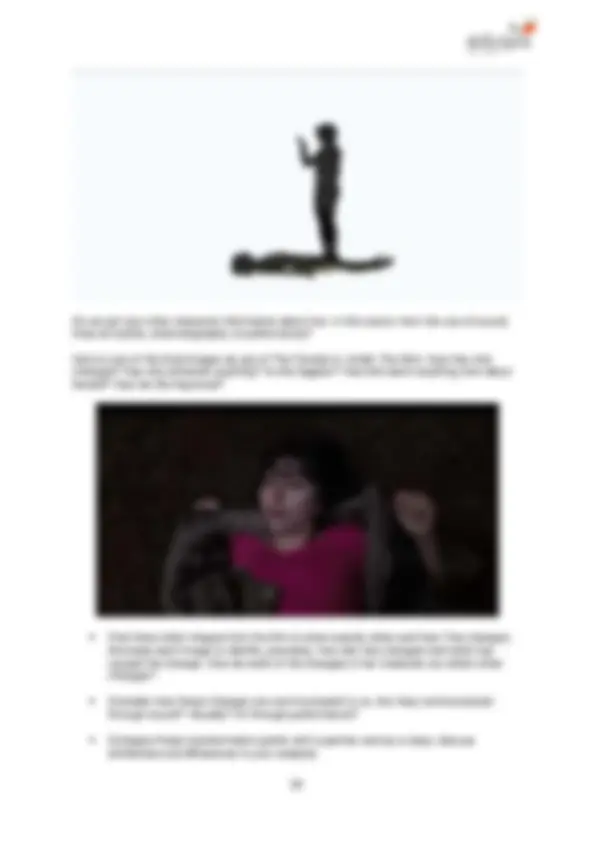




















Study with the several resources on Docsity

Earn points by helping other students or get them with a premium plan


Prepare for your exams
Study with the several resources on Docsity

Earn points to download
Earn points by helping other students or get them with a premium plan
Community
Ask the community for help and clear up your study doubts
Discover the best universities in your country according to Docsity users
Free resources
Download our free guides on studying techniques, anxiety management strategies, and thesis advice from Docsity tutors
Under the Skin is an unconventional and challenging sci-fi/horror film. ... In addition, mise-en-scène, editing, cinematography and sound can all have a ...
Typology: Lecture notes
1 / 26

This page cannot be seen from the preview
Don't miss anything!



















Sightseers (Wheatley, UK, 2012, Big Talk Pictures)
Sightseers is an eccentric and deadpan black comedy in the tradition of British film comedy yet also surprisingly macabre and postmodern in its realisation. It utilises conventional road- movie and rom com narratives but features characters and situations that challenge mainstream representations and responses, particularly in their attitudes to gender and class.
In terms of narrative, Sightseers is conventional; it utilises a traditional linear three-act structure, has clear unity of time and space, causality is explicit and the film’s protagonists are the principal causal agents. This conventional narrative can be a fruitful area of study in considering how the film provokes comic, shocking and surprising responses in audiences.
If used as part of an A2 course, the film can yield some interesting and provocative ideological debates around gender and class representations as well as morality and crime. Sightseers can be used to explore narrative at more advanced study by considering its unusual use of spectator alignment and positioning, and how these may provoke ambiguous and ‘immoral’ allegiances in spectators.
Under the Skin (Glazer, UK, 2014, Film4)
Under the Skin is an unconventional and challenging sci-fi/horror film. It is a cinematically stunning, disturbing and innovative UK film directed by Jonathan Glazer that exemplifies the exciting artistry currently working within UK film. As it is not a mainstream film it will stretch and challenge students in its use of form, narrative and ideological representations – opening their minds to new possibilities in cinema. The film was not a financial success at the box office but was critically acclaimed, particularly for Glazer’s direction, Levy’s score, Landin’s cinematography and Johansson’s performance.
The film’s use of narrative demands more active spectator engagement and leaves much for the viewer to infer from the plot. The traditional three-act structure, character motivation, causality and spatial/temporal unity are less explicit in Under the Skin than in mainstream cinema. In this way, the film is very useful to study, at AS and AL, as it forces students to think deeply about the functions and appeals of conventional narrative structures and devices in cinema.
The film’s representations of gender and its ideological meanings have been a source of great debate since the film was released and students will be provoked into enthusiastic engagement with this debate by the film and its accompanying critical writing. The film’s use of ambiguous iconography, spectator address and formal elements will make ideological analysis challenging but varied and exciting in the classroom.
Narrative structure requires consideration of the whole film, most obviously in the way a
story is told through plot. A practical approach to narrative is to be found in the practice of
screenwriting with the idea of the narrative arc and the commonly used three-act structure.
In addition, mise-en-scène, editing, cinematography and sound can all have a narrative
function.
AS learners study the following :
Critical approaches to narrative:
A2 learners study:
c. Understanding narrative causality
Another game/activity that can be used in approaching narrative analysis is the following:
a phone rings a man dies an ice cube melts a woman is sacked from her job a horse chews some grass.
Or use this to select five random events: Random Event Generator
Teachers’ notes : This activity is very useful for showing that causality is a very natural part of the way in which we think as human beings. Our brain has evolved to look for causal links between things and if we cannot find an obvious causal link between two random experiences we can create an imaginary one by inferring causality. See here for further guidance. What students will create is a cause–effect chain. They will add extra information in the form of motivation and setting, and, may manipulate order, frequency and duration to create effects. What is often interesting is the ways in which they try to create a story using generic or formal schemata – some students may create a very mainstream horror story, others may create a non-generic art cinema story.
d. Plot segmentations
i. Character arcs:
Another way of looking at narrative development is to analyse character arcs. Considering how a character changes and develops throughout the film’s narrative can reveal important structural and technical features of the film. What characters cause to happen and how they are affected by events, what motivates characters and what transformations they go through can be very useful ways of exploring any film text. The character arcs of Tina in Sightseer s and The Female in Under The Skin can be very interesting studies.
This is the very first image we see of her:
Equilibrium
Distruption of the Equilibrium.
Recognition of the distruption.
Do we get any other character information about her, in this scene, from the use of sound, mise-en-scène, cinematography or performance?
Here is one of the final images we get of The Female in Under The Skin. How has she changed? Has she achieved anything? Is she happier? Has she learnt anything new about herself? Has her life improved?
How you answer these questions may help in developing an ideological analysis of these films. You may feel that the construction on narrative and particularly the characters creates a bias towards certain ideological views/positions. A useful starting point for both films would be to consider gender representations.
Teachers’ notes: Narrative in Sightseers
● The contrast of Tina’s character at the beginning of the narrative and at the end can be studied. We see her character arc develop dramatically from being repressed in a mother- dominated home to standing on the edge of a viaduct watching her lover kill himself. How she has developed and changed as a character, and how our relationship with her as a spectator has changed, should be explored. ● The cause–effect chain of the narrative can be explored by considering how the murders affect the characters’ relationship and create a chain of events culminating in the final scene. Although Chris’ psychotic character is initially the cause of the murders, it is Tina’s character that intrudes on this and becomes the more dominant as the narrative progresses.
● The open ending of the film can be discussed in terms of Tina’s motivations and future. We see her let Chris commit suicide alone and she remains looking at her hand as the closing credits roll. This is an enigmatic resolution as we are not entirely sure whether she planned to let Chris die or didn’t have the bravery to jump at the last minute. Also, what do we feel will happen to her now? She has the opportunity to blame it all on Chris now and remain free to, perhaps, continue murdering people.
A2 Study:
The concept of film as ideological involves exploring what ideologies are conveyed by a film as well as those which inform it. These may, for example, reveal that a film reinforces or challenges dominant beliefs and attitudes within a society.
Learners study the following:
a. Gender and Ideology
Traditional gender stereotypes
Feminine Not aggressive Dependent Easily influenced Submissive Passive Home-oriented Easily hurt emotionally Indecisive Talkative Gentle Sensitive to others’ feelings Very desirous of security Cries a lot Emotional Verbal Kind Tactful Nurturing
Masculine Aggressive Independent Not easily influenced Dominant Active Worldly Not easily hurt emotionally Decisive Not at all talkative Tough Less sensitive to others’ feelings Not very desirous of security Rarely cries Logical Analytical Cruel Blunt Not nurturing
https://www.spectator.co.uk/2012/12/caravan-killers/
https://www.bostonglobe.com/arts/movies/2013/05/16/movie-review- sightseers/wn3RFeDVfCjfHMcIS2E1JJ/story.html
https://kaist455.com/2014/07/16/under-the-skin-2013/
https://colinatthemovies.wordpress.com/2014/11/15/body-and-mind-a-review-of-under-the- skin-2013/
http://www.irishtimes.com/culture/film/under-the-skin-1.
http://grantland.com/hollywood-prospectus/under-the-skin-jonathan-glazer-scarlett- johansson-state-of-sci-fi-in-hollywood/
https://onthescreenreviews.com/2014/06/18/under-the-skin-is-sci-fi-back/
Teachers’ notes: Ideology in Sightseers
● The character of Tina can be explored as an ideological representation of women and/or femininity. The mother–daughter relationship we see in the early part of the film is fraught, jealous and damaging and Tina struggles to free herself from it. When she is able to extricate herself from this repression, she explores her sexuality and gender identification in bizarre ways, achieving a strange and challenging form of strength.
● The film’s attitude to death and murder is morally challenging for the spectator. We are encouraged, by the use of sound and image, to laugh at innocent characters being killed without any attempt to encourage sympathy for the victims or antipathy towards the perpetrators. As spectators, we are implicated in the killings by being positioned with the killers. The film overtly suggests that the snob and the promiscuous, binge-drinker deserve to die.
● If we are being aligned, by the narrative and the use of film form, with a psychotically- empowered woman and the immoral pleasures of murder, what does this say about the film’s ideology? Does the film have an ideology? Should films have a moral position and, if so, why? Is an ideological critical approach useful when studying a postmodern film?
Teachers’ notes: Ideology in Under The Skin
● Throughout the film, we are aligned with the female central character. We are constantly watching her and watching others, with her. Students should consider what the film wants us to think about her and how it wants us to feel about her. Should we see her as a woman? Or as something that is becoming a person? Or as an inhuman monster? The film’s ideological position is enigmatic; do we feel anything towards her as she abandons a baby or when she is murdered at the end? Could such meanings be open to spectator interpretation?
● Is it possible to say that this ambiguous and enigmatic movie has an ideology? How useful is it to see the film from a feministic or post-colonial critical approach. Does such an approach lead us into understanding or appreciating the film any further?
● How the film represents Scotland and Scottishness could be usefully explored. In many ways, the film reinforces ethnic stereotypes and uses clichéd imagery of Scotland. However, we also see counter-typical representations in its portrayal of lonely characters and the isolating nature of the physical environment.
Teachers’ notes: Key sequence analysis in Sightseers
One: Death on the Rocks 0:17:44 – 0:19:
Two: The Power of Love 0:59:00 – 1:01:
STARTING POINTS – Key elements of film form (micro features)
Cinematography
Artificial lighting was minimal on the film creating a flat, low-contrast look which adds to the sense of mundane realism in the film. The use of largely natural lighting means that there is a lack of shadowing and the outdoor sequences have a very dour look because of the overcast weather conditions or harshly lit at times when the sun shines through clouds.
● Laurie Rose, the cinematographer, limited the number of lenses he used to mainly a 50mm and a wide-angle lens for landscapes to maintain a natural look to the film. He wanted to have a documentary approach to the cinematography for quicker and more flexible shooting because many of the scenes were improvised.
● Many of the landscape shots utilise foggy landscapes and overcast skies to create beautiful and threatening environments for the scenes of black humour. The use of sunrise and sunset shooting, particularly, add to the attractive yet brooding look of the film.
STARTING POINTS – Meaning and response
Representations
● There are several overt uses of English stereotypes in the film. The yobbish father littering, the promiscuous binge-drinking hen party, the snobby member of the National Trust. All of these characters are mercilessly killed without any attempt to encourage spectator sympathy in the film.
● Chris and Tina represent stereotypes of anorak-nerds. Chris has a trainspotter’s fascination with caravans and Tina obsesses over her gonks. These representations serve to make their murderous and evil personalities more disconcerting but, perhaps also more worryingly, child-like too, “I just want to be feared and respected – that’s not too much to ask, is it?”
● The representations of Chris and Tina as male and female killers can be usefully contrasted in their murder scenes. Whilst the film begins with Chris as the experienced controlling character who leads Tina away from her mum and then into murder, it is Tina who proves to enjoy murder and be more calculating than Chris at the end of the film.
Aesthetics (i.e. the look and feel of the film including visual style, influences, auteur, motifs)
● The look of the film is dominated by a documentary aesthetic (the use of natural lighting, improvisation, location shooting, etc) which adds a sense of spontaneity and realism and makes the subject matter all the more shocking and original.
● The beautiful shots of English landscapes transform the rather mundane aesthetic of the film at times to create cinematic moments that suggest metaphorical meaning in an otherwise off-beat genre movie.
● The reoccurring motifs of the inexpressive faces of Chris and Tina add a clear sense of unease in the film. We constantly see them exchanging blank and static facial expressions in moments of heightened emotion or violent excess.
Teachers’ Notes: Key Sequence Analysis in Under The Skin
One: The opening sequence. 0:0:00 – 0:8:
Two: Prowling for victims. 0:14:26 – 0:24:
STARTING POINTS – Key Elements of Film Form (Micro Features)
Cinematography
The use of hidden dash cams in the van as the alien drives around trying to pick up men. We see close-ups of Johansson’s expressionless face as she prowls the streets, which only becomes expressive as she engages with her intended victims. We see the victims from a distance through hidden, short focal length cameras which capture unscripted conversations with the A-List star Johansson. The sense of spontaneity and realism is very powerful and positions us with the alien in the van.
● The use of a long-shot as we see the alien drag her victim from the beach intensifies the sense of vulnerability and isolation of the baby who is left alone crying for its parents. The alien’s lack of empathy becomes more horrific later as we see the motorcyclist clearing up the scene and ignoring the crying baby. We see a traumatic final mid close-up of the distraught baby unable to walk and isolated on the beach.
● In the opening sequence, we see the female alien through close-ups, establishing her character through detailed views of parts of her body. The character is literally constructed before our very eyes.
Mise-en-scène
● The enigmatic visuals in the opening sequence carry some connotations of the science fiction and horror genres. We see blinding lights and dark objects that look like planets or body parts. We see an eye in extreme close-up with its pupil dilating.
● More visual enigmas are developed in the opening sequence as we see a motorcyclist riding down an isolated road and then stop mysteriously to retrieve a body. It is very dark and the situation or its causes are withheld from us.
There is a third dramatic change in the mise-en-scène of the opening sequence as we see a very bright and stark white room in which a female character undresses the body we have just seen retrieved and puts on her clothes. The figures are very dark against the white background, creating an otherworldly contrast. More visual mystery is developed in the use of an extreme close-up of an ant to complete the sequence.